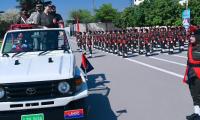Last week turned out to be very disappointing. It really pained many Pakistanis to see political leaders making personal attacks that further dented their reputation. The vitriolic attacks by Finance Minister Asad Umar on Bilawal Bhutto Zardari, the bizarre style of sycophancy demonstrated by Faisal Vawda on a TV talk show and some of the comments regarding Prime Minister Imran Khan by some PPP leaders were all really deplorable.
However, amidst this unhealthy race, there seems to be a healthy competition going on between political parties and their provincial governments as well. The Sindh government has launched a low-cost housing scheme apparently to counter the ambitious housing project of the PTI’s federal government. The scheme deserves appreciation, and is sure to benefit those that need decent housing. The much-vaunted housing project of the PTI will also benefit those on the bottom layer of social stratification. So, this competition between the two parties could turn out to be a blessing.
Successive governments have ignored this crucial sector to appease corporate entities and real-estate tycoons. Inaction on the part of governments has complicated housing issues across the country. The ruling elite doled out thousands of acres of land to various construction companies, many of whom launched fake housing schemes, pocketed lifelong savings of people and disappeared. Others acquired lands from the government at throwaway prices, selling it out at exorbitant rates. Elite gated communities also drove up the price of land which witnessed a big boost since the 1980s owing to deindustrialisation and the neo-liberal policies of various governments. The privatisation of estate concerns also led to the mushroom growth of housing societies because potential buyers were more interested in the land they could get with the privatised state industrial or commercial entity rather than running cumbersome manufacturing state units. In Karachi and Hyderabad, the privatisation of some cement factories led to the establishment of housing colonies.
Since the country did not witness any major project to industrialise, the concentration of capital was seen in the real-estate sector where making quick money has been one of the motivating factors. Overseas Pakistanis have also contributed to this concentration because it was easy to invest in a plot rather than investing in a manufacturing or commercial units and supervising it round the clock. Real estate has also served to whiten black money in the last four decades.
But before the Sindh government counters the federal housing project through the new Taiser Town housing scheme, it is important that any and all claims regarding encroachment in the old Taiser Town housing scheme are investigated and acted on. There are serious claims that the previous scheme did not see much development work despite a lapse of more than 16 years.
So, a competition in housing between the PTI and the PPP could turn out to be very healthy and would benefit common Pakistanis. There is much disparity in this crucial sector. For instance it is claimed that in the largest city of Pakistan on an average more than 12 people are residing in an eight-yard-square house in a working class area while the average for an elite area is hardly two persons on average in a 600-yard house in any ultra-modern housing colony or elite gated community. The doling out of farm houses to influential bureaucrats, businessmen and politicians also contributed to the creeping housing crisis.
But such competition should not be confined to the housing sector only. For instance, recently PPP leader Saeed Ghani uploaded photographs of a school in Khyber Pakhtunkhwa surrounded by heaps of garbage. The PPP is also highlighting the delay in the construction of the Peshawar Metro. It would be good if the PTI in turn highlighted the non-functional schools in Sindh and the infants that die of malnutrition in Thar. Such competition will let people know about the performance of their elected representatives as well as place a pressure on provincial governments to work on people’s issues.
It is true that the PPP government has done some good work in various sectors, especially healthcare. The condition of Jinnah and Civil hospitals has improved a lot in the past eight years. The cancer facility close to Jinnah Hospital and the National Institute of Cardiovascular Diseases have both been appreciated. Such facilities have also witnessed some improvement even in working class areas. For instance, Sindh Government Hospital Korangi No 5, which is frequently visited by industrial workers of Landhi and other low-income areas, offers free medicines, surgeries and a number of vaccines.
A competition could generate a debate about more important issues of common people, which is far more important than the current sparring in parliament over leaders’ personalities. The N League could highlight the recent fee hike in various hospitals of the province frequented by common residents of Punjab. The PTI in turn could reveal the whopping amount that was pumped by the N league into capital-intensive programmes in Punjab at the cost of crucial sectors like health, education, sanitation etc.
Would it not be nice if all political parties set targets related to improvement in social and human development? Should there not be a vigorous race between these political entities at putting more than 25 million out-of-school children back into school, preventing the stunting of more than 40 percent Pakistani children, providing pure drinking water to the vast majority of Pakistanis, eliminating honour killing and lifting 60 million people out of poverty?
Can one hope that political parties will come up with performance sheets during the next election campaign showing the number of people they lifted out of poverty, the amount of money spent on health, education, housing and sanitation and the resources allocated to the uplift of rural areas and marginalised sections?
People are tired of the senseless rounds of personal attacks unfolding in front of them since the restoration of democracy in the late 1980s. Now, they want to see a competition between political parties that could alleviate their miseries and hardships. If the N league failed to run the Steel Mills, they want the PTI to make it functional and turn it into a profitable entity. If the PPP failed in tiding over corruption, the masses might want another party to address this issue – with full vigour instead of carrying out a selective accountability. If the National Party established six medical colleges and universities in Balochistan, Balochistan Awami Party should defeat its rivals by building 12 such facilities. If Achakzai allegedly stuffed top posts in Balochistan with his own relatives and friends, Imran Khan should make a clear difference by refusing to award any post to his acquaintances and buddies. This is the type of competition that people might want to see in this country before the next general elections.
The writer is a freelance journalist.
Email: egalitarianism444@gmail.com
A representational image showing residents walking at a wholesale market in Karachi. — AFP/FileOnce again there is...
A representational image showing late Pakistani human rights activist and Supreme Court lawyer Asma Jahangir. —...
A representational image showing a security personnel sanding guard beside a ship carrying containers at Gwadar port....
A health worker administers polio vaccine drops to a child during a door-to-door polio vaccination campaign in Lahore,...
Armed militants of the banned Tehreek-e-Taliban Pakistan pose for a photograph in Orakzai Agency. —...
An aeroplane of the national flag carrier of Pakistan is seen in this file photo. — AFPWhile Pakistan considers...







